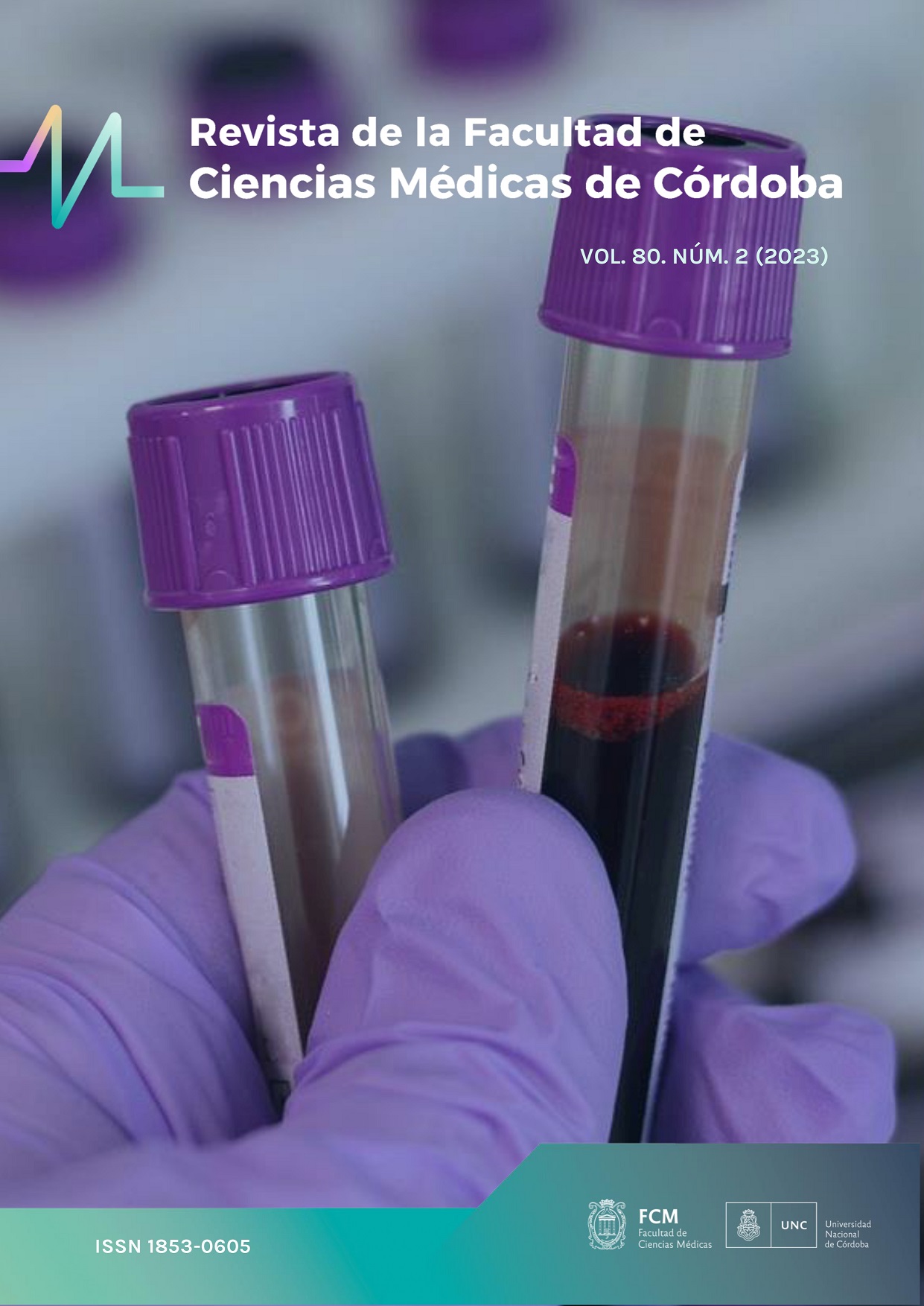Quimioterapia al final de la vida es compatible con muerte digna y cuidados paliativos
DOI:
https://doi.org/10.31053/1853.0605.v80.n2.37489Palabras clave:
oncología médica, quimioterapia, cuidados paliativos, muerteResumen
Introducción: El tratamiento oncológico es cada vez más agresivo. El objetivo de este trabajo fue estimar las personas fallecidas por causa oncológica, reportar la frecuencia de uso de quimioterapia (QT) en los últimos 3 meses de vida, y describir las características clínicas-epidemiológicas de estos pacientes.
Métodos: Se incluyó una muestra consecutiva de fallecidos durante el 2017, afiliados a prepaga del Hospital Italiano de Buenos Aires. Mediante revisión de historias clínicas, se los clasificó según la causa de muerte (oncológico u otra causa), validando diagnóstico y estadio de base, performance status (PS). Se reportan prevalencias con IC95% y se utilizó estadística descriptiva.
Resultados: Fallecieron 2293 personas, 59% mujeres con mediana de 84 años. Hubo un total de 736 fallecidos por cáncer, representando el 32% (IC95% 30-34). Este último subgrupo presentó una mediana de 75 años, 54% eran mujeres y sólo una paciente tenía directivas anticipadas. En cuanto al lugar de fallecimiento, 80% ocurrió hospitalizado (65% sala general y 15% unidad cerrada). Los tumores más frecuentes fueron: pulmón, colorrectal-gástrico, hematológico, y mama. Un total de 390 pacientes recibieron QT al final de la vida (53%; IC95% 49-57), siendo 53% mujeres y con promedio de 68 años. En cuanto a la enfermedad oncológica de base: 81% tenían tumor sólido, 75% estadío avanzado, y mayoritariamente con mala/regular capacidad para realizar actividades cotidianas (25% PS3 y 32% PS4 respectivamente).
Conclusión: Existe una frecuencia preocupante del uso de QT en el fin de vida y los fallecimientos siguen siendo principalmente intrahospitalarios.
Descargas
Citas
Wilkerson DH, Santos JL, Tan X, Gomez TH. Too Much Too Late? Chemotherapy Administration at the End of
Life: A Retrospective Observational Study. Am J Hosp Palliat Care. 2021 Oct;38(10):1182-1188. doi: 10.1177/1049909120966619.
Visser M, Deliens L, Houttekier D. Physician-related barriers to communication and patient- and family-centred decision-making towards the end of life in intensive care: a systematic review. Crit Care. 2014 Nov 18;18(6):604. doi: 10.1186/s13054-014-0604-z.
Harrington SE, Smith TJ. The role of chemotherapy at the end of life: "when is enough, enough?". JAMA. 2008 Jun 11;299(22):2667-78. doi: 10.1001/jama.299.22.2667.
Mohan D, Alexander SC, Garrigues SK, Arnold RM, Barnato AE. Communication practices in physician decision-making for an unstable critically ill patient with end-stage cancer. J Palliat Med. 2010 Aug;13(8):949-56. doi: 10.1089/jpm.2010.0053.
Urvay S, Civelek B, Özaslan E, Sürel AA. Chemotherapy at the End of Life. J Palliat Care. 2021 Apr;36(2):73-77. doi: 10.1177/0825859720946505.
Prigerson HG, Bao Y, Shah MA, Paulk ME, LeBlanc TW, Schneider BJ, Garrido MM, Reid MC, Berlin DA, Adelson KB, Neugut AI, Maciejewski PK. Chemotherapy Use, Performance Status, and Quality of Life at the End of Life. JAMA Oncol. 2015 Sep;1(6):778-84. doi: 10.1001/jamaoncol.2015.2378.
Novoa-Jurado A, Melguizo-Jiménez M. La Medicina de Familia ante la ley sobre la ayuda médica para morir: responsabilidad y garantías [Family Medicine in the face of the law on medical aid in dying responsibility and guarantees]. Aten Primaria. 2021 May;53(5):102058. Spanish. doi: 10.1016/j.aprim.2021.102058.
Santos Pérez MI, Godoy Díez M, Abajo Del Álamo C. Quimioterapia al final de la vida: ¿práctica clínica poco frecuente? [Chemotherapy at the end of life: Uncommon clinical practice?]. J Healthc Qual Res. 2019 Jul-Aug;34(4):201-207. Spanish. doi: 10.1016/j.jhqr.2019.04.002.
Zdenkowski N, Cavenagh J, Ku YC, Bisquera A, Bonaventura A. Administration of chemotherapy with palliative intent in the last 30 days of life: the balance between palliation and chemotherapy. Intern Med J. 2013 Nov;43(11):1191-8. doi: 10.1111/imj.12245.
Wilkerson DH, Santos JL, Tan X, Gomez TH. Too Much Too Late? Chemotherapy Administration at the End of Life: A Retrospective Observational Study. Am J Hosp Palliat Care. 2021 Oct;38(10):1182-1188. doi: 10.1177/1049909120966619.
Mohan D, Alexander SC, Garrigues SK, Arnold RM, Barnato AE. Communication practices in physician decision-making for an unstable critically ill patient with end-stage cancer. J Palliat Med. 2010 Aug;13(8):949-56. doi: 10.1089/jpm.2010.0053.
Montalva VA, Guadalupe MT, Buendía YY, Alvarez PP, Saldarriaga FF. Quimioterapia y alternativas en el cáncer terminal: Desafío pendiente para el Perú. An Fac med. 2016 Jun 24;77(2):179–80.
Clarke G, Johnston S, Corrie P, Kuhn I, Barclay S. Withdrawal of anticancer therapy in advanced disease: a systematic literature review. BMC Cancer. 2015 Nov 11;15:892. doi: 10.1186/s12885-015-1862-0.
Wilkerson DH, Santos JL, Tan X, Gomez TH. Too Much Too Late? Chemotherapy Administration at the End of Life: A Retrospective Observational Study. Am J Hosp Palliat Care. 2021 Oct;38(10):1182-1188. doi: 10.1177/1049909120966619.
Kenny P, Street DJ, Hall J, Agar M, Phillips J. Valuing End-of-Life Care for Older People with Advanced Cancer: Is Dying at Home Important? Patient. 2021 Nov;14(6):803-813. doi: 10.1007/s40271-021-00517-z.
Publicado
Cómo citar
Número
Sección
Licencia
Derechos de autor 2023 Universidad Nacional de Córdoba

Esta obra está bajo una licencia internacional Creative Commons Atribución-NoComercial 4.0.
La Revista de la Facultad de Ciencias Médicas de Córdoba (RFCM) adhiere a la política de Acceso Abierto y no cobra cargos a los autores para publicar, ni tampoco a lectores para acceder a los artículos publicados.




